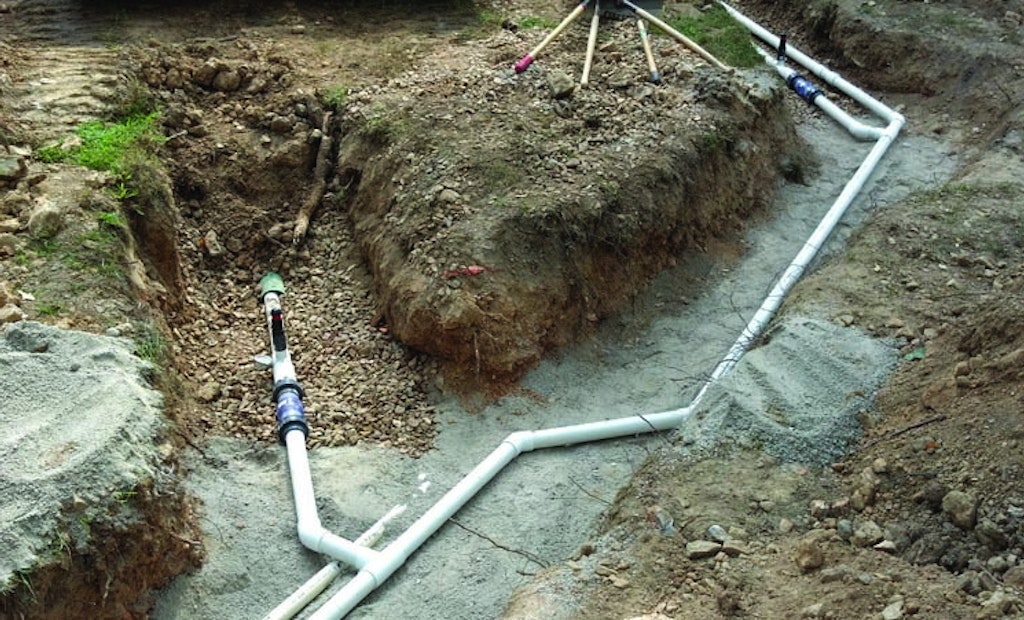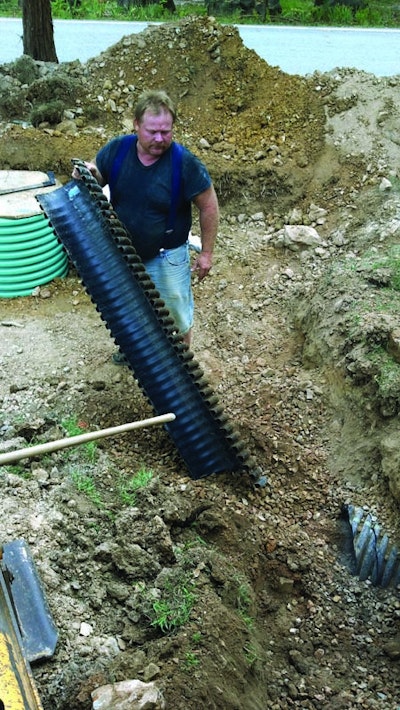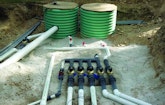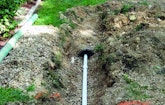
Jon Hancock, owner of Envirotek Systems in Kimberling City, Missouri, had a crew doing some repair work on a residential street at Missouri’s Table Rock Lake. A well serving several properties was located a few doors away, and Hancock introduced himself to a homeowner as he searched for the water supply. The homeowner then stopped by to watch Hancock’s crew work and asked Hancock to look at his system. It was obvious the system needed attention.
“The first time we pulled into the subdivision we could smell it. So could everyone else,” Hancock says. The distribution field was across the street from the lakeside home, and aside from putting out a significant smell, Hancock saw at a glance that one end of the field was very wet. That’s where the previous installer had put the distribution buckets – actual 5-gallon buckets with holes cut in the side for pipes to enter. They did a partial job of feeding the laterals. Water traveled only about 20 feet in the 150- to 184-foot-long pipes.
For the drainfield the previous installer used 10-foot lengths of perforated 4-inch pipe surrounded by gravel, but about every 20 feet those stopped and were alternated with sections of N-12 pipe cut in half and installed cut side down and filled with gravel.
“And all the pipe runs we checked, other than the far end, had never received any effluent at all. I tried to reverse engineer his thought process on that, and I never did come up with a good reason why he did what he did,’’ Hancock says of the previous installer. “His workmanship was good, but he was not up to date on the technology we have available.”
New system from old
In designing the new system, Hancock took advantage of what was already in the ground. It saved his crew labor and saved the customer money.
The home sits below the level of the treatment site. Waste first flows to a grinder pump that pushes it through about 170 feet of 2-inch discharge pipe that rises about 15 feet from the house to the treatment area.
The pipe empties into the existing 700-gallon septic tank. It had been formed in the mold for a coffin vault, not uncommon in this area where companies use the same basic mold to expand into another market. The tank is divided into three chambers with the final chamber sloped for return treatment. An air pump had been connected originally but was removed when it quit working.
Hancock did not install a new air pump. The home is occupied only intermittently, and he does not believe an aerobic system is best in such situations because aerobic microbes require a steady supply of food. The owner did agree to let the crew add conduit and fittings for future advanced treatment technology if needed.
As it leaves, the tank water flows by gravity through a Zoeller filter and into two pump basins made of 30-inch-diameter, 6-foot-long plastic pipe. A connection at the bottom allows the basins to share a liquid level. One basin contains a new pump built by Envirotek. The other basin retains the customer’s old pump. Most of the time the system will function with the Envirotek equipment and electrically operated valves, all powered by a separate electrical service running to the lot that holds the system. But if there is a power failure — and these happen every few years in this part of the country — the customer needs only flip a switch beneath the control panel to bypass the electrically operated valves and use the old pump, which is powered by the service running to his house across the street.
The pumps feed water through 2-inch pressure lines fitted with orifice shields from Sim/Tech. These lines were placed inside the 4-inch pipe and under the split N-12 pipe, and the entire system is controlled by a panel that Envirotek builds, so Hancock can use a touch screen to program in functions he wants and eliminate components that experience taught him are unreliable.
To complete the earthwork, Hancock’s crew used a model 214 JCB loader backhoe with four-wheel drive and a telescoping boom that adds about another 4 feet of reach. For the finish work, and because conditions were very wet, they rented a compact John Deere utility tractor with a three-point hitch to do the finish grading.
Limited digging
Reusing much of the old system saved considerable work. New distribution pipes were threaded through the existing 4-inch pipes and N-12 chambers from the ends of the laterals. The crew made holes in specific areas to install new pressure line feeds, return lines, the new pump basins and check valves.
Hancock’s crew installed legs on the grinder pump. A local plumber had not done this, and the pump’s teeth were chattering against the bottom of its small tank.
A new inlet fitting was created using a PVC sheet anchored to the tank with a Uniseal grommet, and custom vents were built into the riser lids to relieve pressure when the grinder pump pushes waste into the tank. Hancock fabricated a carbon filter for the vent to limit odors. Similar vents are located throughout the system allowing pressure lines to fill faster. When the pump turns off, water in the flush lines drains back to the basins. Because the original laterals were not installed level, Hancock’s crew installed check valves to prevent effluent from settling in one end of a lateral and saturating the soil there.
Test first, then install
To better ensure the upgraded system would work properly, Hancock built a complete mock-up at his shop, including all the changes in elevation.
“I have great faith in engineers, but I learned over the years that what I read on paper was not how a system actually performed. After installing and seeing hodgepodge work, and after being an inspector, I realized I had been making a lot of assumptions about how things functioned in the ground.”
By testing, he knows whether a pump rated for 50 gpm actually produces 50 gpm under the conditions he plans to use it. Testing allowed his crew to make sure the head heights met minimum requirements when the pump was on. They could time how long it took sections of the laterals to fill and so know how to program pump cycles on the panel.
“When the owner first approached me, he says, ‘Jon, I’ve had all kinds of plumbers and excavators in here to look at my system. When I learned you were actually a technician, I realized you were the guy I needed to talk to,’” Hancock says.
This customer was not required to fix his system, Hancock says. He could have left it alone, but because he wanted to eliminate odors for his neighbors, and because he wanted to protect the water quality of the nearby lake, he chose to do the responsible thing. The result, according to Hancock, is a well-functioning wastewater system, happy neighbors and the practical use of more of the property. With the odors tamed and the system now almost invisible, the ground above the wastewater system has become a picnic spot for the homeowner’s family and their guests.









